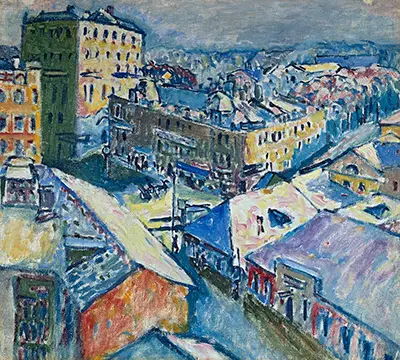 Buy Art Prints Now
Buy Art Prints Nowfrom Amazon
* As an Amazon Associate, and partner with Google Adsense and Ezoic, I earn from qualifying purchases.
This beautiful painting captures a square in Moscow that the artist refered to in German as Zubovsky Platz. The artwork was finished in 1916, during which Kandinsky was going through something of a stylistic transition.
Prior to this artwork, much of Kandinsky's paintings featured large expanses of colour to produce abstract landscapes. Here he concentrates on a city based theme, and incorporates much more detail right across the canvas. Whilst more traditional in that sense, it is still entirely expressive, looking to suggest at reality rather than attempting to perfectly recreate it. His colour choices are also very personal, and rather than simply matching the tones of what he saw at the time, he falls back on his own palettes that are found elsewhere in his career, with yellows, blues and purples being particularly dominant. The focus is on the Zubovsky Platz, though the city continues off into the background, with detail becoming more and more blurred as we look off into the distance.
Kandinsky would later become far more abstract in his approach, reducing everything down to a two dimensional array of squares and circles, akin to the night sky. Many still prefer paintings such as Zubovsky Platz, even though they are lesser known within his overall career. It is the combination of abstract art, whilst still being rooted and styled in reality, that makes these types of works popular as prints, as they appear bright, contemporary and also immediately accessible for even though the occasional art follower.
This relatively small artwork can be found in the collection of the Lenbachhaus in Munich, Germany. They were gifted a large amount of work from artist Gabriele Munter, someone who had a strong relationship with Kandinsky and who built up a collection of work from artists related to the Blue Rider movement. These included Franz Marc who remains a much loved artist in his own right and whilst not perhaps quite as famous as Kandinsky, is a key part of understanding the changes that happened in the early 20th century art scene. He liked to fracture his forms up in a similar way to the Cubists, but this German worked much more closely with other collaborators in the domestic scene rather than merging into the French groups of artists.




